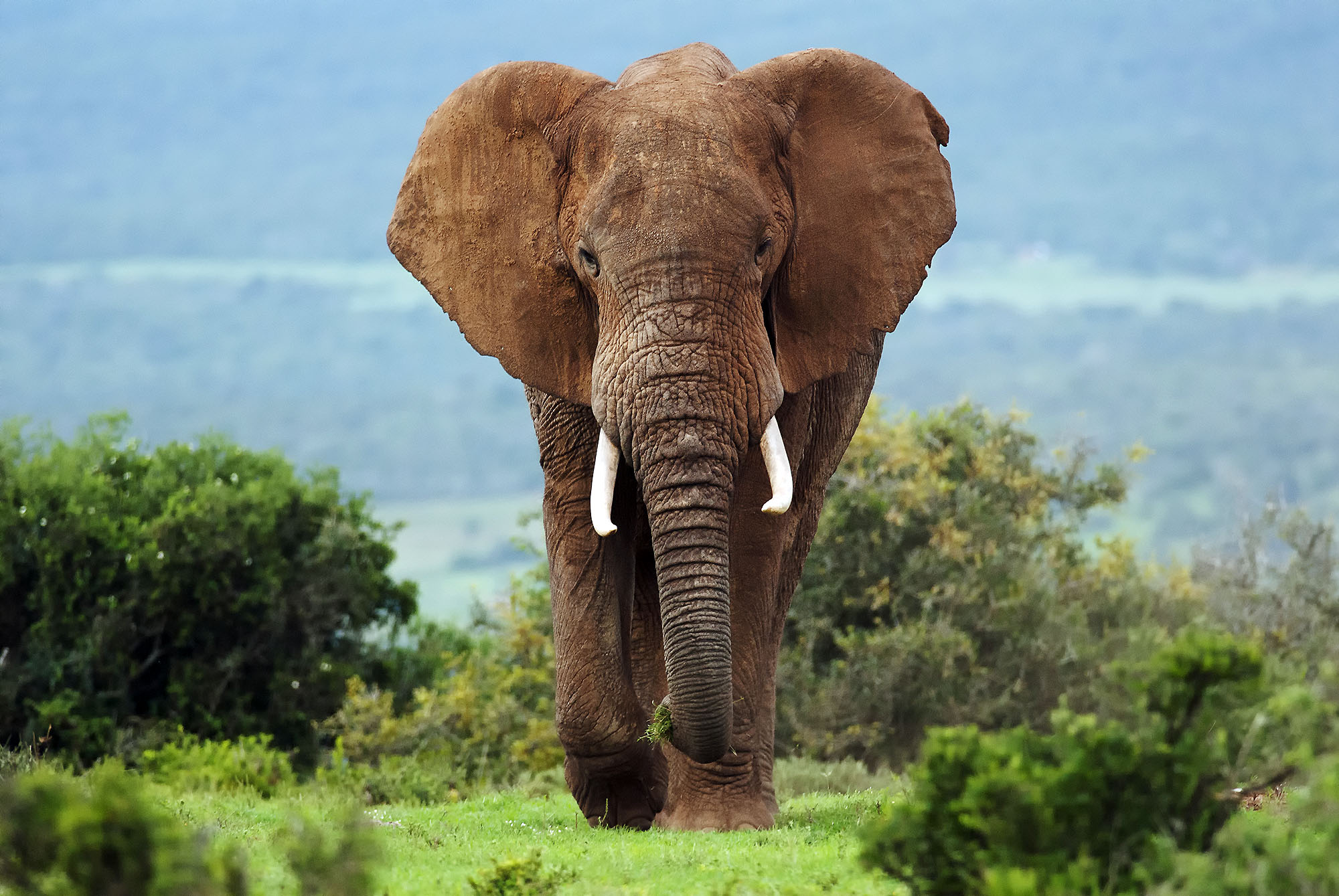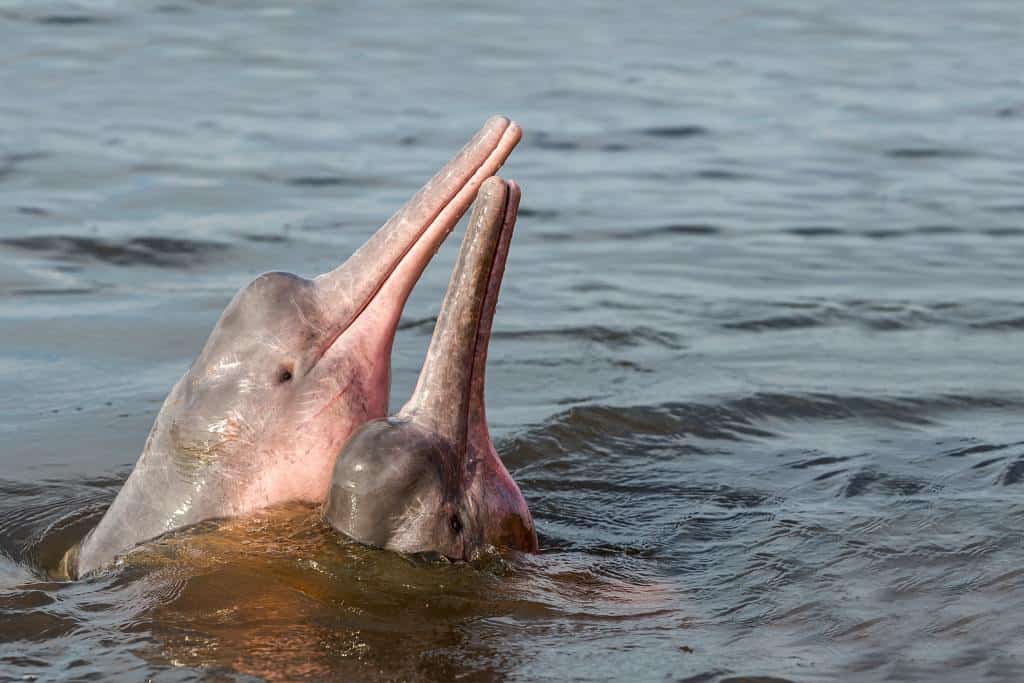1/11/2024 by Active Wild Admin
Endangered Animals List With Pictures & Interesting Facts – Updated 2024
Endangered Animals
Examples of endangered animals include mammals such as the tiger, chimpanzee, Asian elephant, & sea otter; birds such as the Egyptian vulture & Galápagos penguin; reptiles such as the Alabama red-bellied cooter & green sea turtle; fish such as the humphead wrasse & whale shark; & amphibians such as the golden poison frog & Majorcan midwife toad.
All of the animals on the list below are currently (as of Jan 2024) listed as “Endangered” by the International Union for Conservation of Nature.
African Bush Elephant
Scientific name: Loxodonta Africana
Type of animal: Mammal
Where found: Africa
The African bush elephant (also known as the African savanna elephant) is the world’s largest living land animal. Large males can weigh up to 10.4 metric tonnes / 11.46 short tons (22,928.08 lb.).
Both male & female African bush elephants have tusks, which are teeth that project out of the mouth.
Why are African bush elephants endangered?
The African bush elephant’s endangered status is due mainly to illegal poaching for their valuable ivory tusks, together with loss of their natural habitat.
African Spurred Tortoise
Scientific name: Centrochelys sulcata
Type of animal: Reptile
Where found: Africa
The African spurred tortoise is the 3rd-largest type of tortoise in the world, & the largest found on the mainland; only the Galapagos tortoises & the Aldabran tortoise are larger (these tortoises are found on islands).
The African spurred tortoise can reach lengths of 83 cm (33 in) & weights of 105 kg (231 lb.). It is found in the Sahara Desert & the Sahel; a dry grassland / savanna region that stretches across Africa from Mauritania in the west to Ethiopia & Eritrea in the east.
Why are African spurred tortoises endangered?
Primary causes for the African spurred tortoise’s endangered status are habitat loss (due to farming & bush fires), capture for the pet trade, & being hunted for meat.
African Wild Dog
Scientific name: Lycaon pictus
Type of animal: Mammal
Where found: Africa
African wild dogs are found in Sub-Saharan Africa (the part of Africa south of the Sahara Desert). These endangered canids live in packs consisting of an alpha pair & their offspring. They hunt at dawn & dusk, pursuing prey such as Thomson’s gazelles & other mid-sized antelopes.
The African wild dog is easily identified due to its patterned coat, which gives the species its alternative name of African Painted Dog.
It is estimated that fewer than 1,500 adult individual African wild dogs are left in the wild. The species’ population is fragmented over a wide area.
Why are African wild dogs endangered?
The biggest threat to the African wild dog is habitat loss. This is a species that needs a lot of space; a growing human population in the dogs’ natural habitat restricts the area in which it can hunt.
Alabama Red-Bellied Cooter
Scientific name: Pseudemys alabamensis
Type of animal: Reptile
Where found: North America
The Alabama red-bellied cooter is a species of turtle found in Alabama’s Mobile–Tensaw River Delta, a 260,000 acre wetland region. The species is Alabama’s official state reptile.
The Alabama red-bellied cooter grows up to 1 ft. / 30 cm in length & its plastron (the shell covering the turtle’s undersides) is orange in color (hence the species’ name).
This endangered reptile belongs to the family Emydidae, whose members are also known as “pond turtles” or “terrapins”.
Why are Alabama red-bellied cooters endangered?
Alabama red-bellied cooters are endangered primarily due to habitat loss & illegal capture for sale to the pet trade. They can also become trapped & drown in fishing nets & crab pots.
Amazon River Dolphin / Boto
Scientific Name: Inia geoffrensis
Type of Animal: Mammal
Family: Iniidae
The Amazon river dolphin, also known as the boto or pink river dolphin, is the largest river dolphin species. It is found in the Amazon River & its tributaries.
As an Amazon river dolphin matures, its skin changes from gray to pink in color, resulting in the species’ alternative name of “pink river dolphin”.
The Amazon river dolphin is closely related to the Bolivian, Orinoco, & Araguaian river dolphins (all of which are found in South America); some scientists consider some or all of these dolphins to be subspecies of the Amazon river dolphin, rather than separate species.
Why Are Amazon River Dolphins Endangered?
The Amazon river dolphin is endangered for a number of reasons, including: lack of food due to the presence of commercial fisheries; being caught as bycatch by local fishermen; being deliberately caught & used as bait by local fishermen; & pollution of its habitat.
Arroyo Toad
Scientific name: Anaxyrus californicus
Type of animal: Amphibian
Where found: North America
The arroyo toad is found in California, U.S.A. & Baja California, Mexico, where it inhabits streams & washes (dry desert creeks that fill with water after rain). It is small (2-3 in. / 5-7.5 cm) & stockily-built, with pale, olive-green / grey skin.
Outside of the mating season, the arroyo toad spends much of the day buried in sand or mud, emerging at night to forage for ants & other small insects. During the dry season, it enters a state of dormancy known as aestivation.
Why are arroyo toads endangered?
The arroyo toad population currently consists of fewer than 3,000 individuals & continues to decrease. The species is endangered primarily due to habitat loss.
Asian Elephant
Scientific name: Elephas maximus
Type of animal: Mammal
Where found: Asia
Asian elephants are the largest land animals in Asia, & the second-largest in the world (after the African bush elephant, another endangered species). A large male has a shoulder height of around 9 ft / 2.74 m, & weighs around 4 metric tonnes / 4.4 short tons (8,818.49 lb.).
Asian elephants have smaller ears & smoother skin than their African cousins. Only the males have tusks.
Why are Asian elephants endangered?
Asian elephants are endangered due to poaching (male elephants are targeted for their valuable ivory tusks) & habitat loss.
Aye-Aye
Scientific name: Daubentonia madagascariensis
Type of animal: Mammal
Where found: Madagascar
The aye-aye is a species of lemur that lives in the rainforests of Madagascar, an island located in the Indian Ocean off the coast of East Africa.
The endangered mammal, which reaches a length of around 3 ft. (90 cm), including its long tail, is the world’s largest nocturnal primate.
The aye-aye finds food by tapping on trees with its fingers; it can tell by the sound if there’s an insect grub hidden beneath the bark.
Why are aye-ayes endangered?
Some local people believe that the aye-aye brings bad luck, & the species has faced persecution due to these beliefs. This, and habitat loss, are the main reasons that the aye-aye is endangered.
Barbary Macaque
Scientific name: Macaca sylvanus
Type of animal: Mammal
Where found: Africa, Gibraltar
A small colony of Barbary macaques lives in Gibraltar (a British territory on the southern coast of Spain), making the species the only monkey to be found in the wild in Europe. Barbary macaques are also found in northern Africa.
Unlike most other monkeys, the Barbary macaque lacks a tail. This has led to the species’ alternative name of “Barbary ape” (apes lack tails).
Why are Barbary macaques endangered?
In Africa, the Barbary macaque lives in high-altitude forests, & in Gibraltar, in rocky coastal areas. It is due to the loss of its African habitat that the monkey is endangered.
Basking Shark
Scientific name: Cetorhinus maximus
Type of animal: Fish
Where found: Oceans worldwide
The basking shark is the world’s second-largest fish. It grows to an average length of 26 ft / 7.9 m, but can reach lengths of up to 28 ft / 8.5 m; only the whale shark, another endangered species, is larger.
Unlike most sharks, the basking shark is a filter feeder rather than an active hunter. It swims through clouds of zooplankton (tiny ocean animals) with its large mouth held wide open, filtering the food from the seawater with comb-like projections from its gills known as “gill rakers”.
Why are basking sharks endangered?
The basking shark is endangered due to overfishing. Although the species is no longer targeted, it is still caught accidentally &, due to its surface-feeding habits, is occasionally struck by boats.
Black-Footed Ferret
Scientific name: Mustela nigripes
Type of animal: Mammal
Where found: North America
A list of endangered animals is not just about famous animals such as tigers & elephants; other, lesser-known species are also facing extinction.
The black-footed ferret is one such animal. Found in North America, it is a member of the family Mustelidae, which also includes weasels, badgers, the wolverine, & related animals.
In 1979 the black footed ferret was thought to be extinct in the wild, but in 1981 a small population was discovered in Wyoming.
A captive breeding program saw the species being reintroduced in several locations in North America.
Although several thousands of black footed ferrets have been reintroduced since the 1990’s, today’s wild population consists of just 206 adults.
Why are black-footed ferrets endangered?
Black-footed ferrets are endangered due to persecution of its main prey source, prairie dogs. The black-footed ferret’s fortunes are directly linked to the availability of these prey animals. Prairie dogs are capable of damaging crops, & were therefore persecuted by farmers. This, together with habitat loss, led to a fall in prairie dog populations, & a resultant decline in the black footed ferret population.
Black-Headed Spider Monkey
Scientific name: Ateles fusciceps
Type of animal: Mammal
Where found: Central & South America
The black-headed spider monkey is an endangered monkey found in tropical & subtropical forests in Colombia, Ecuador, & Panama.
The black-headed spider monkey has black or dark brown fur (it is also known as the brown-headed spider monkey). Like all spider monkeys it has extremely long limbs & a long, prehensile tail. (Prehensile means “able to grab”.) The tail is used like a “5th hand” while the monkey is climbing.
Of the 7 species of spider monkey, five (including the black-headed spider monkey) are endangered, one is critically endangered, & one is rated “Vulnerable”.
Why are black-headed spider monkeys endangered?
The black-headed spider monkey is endangered due to being hunted for food, & by the loss & fragmentation of its forest habitat.
Cute Critter Pics:
Weekly Chuckle:












No comments:
Post a Comment